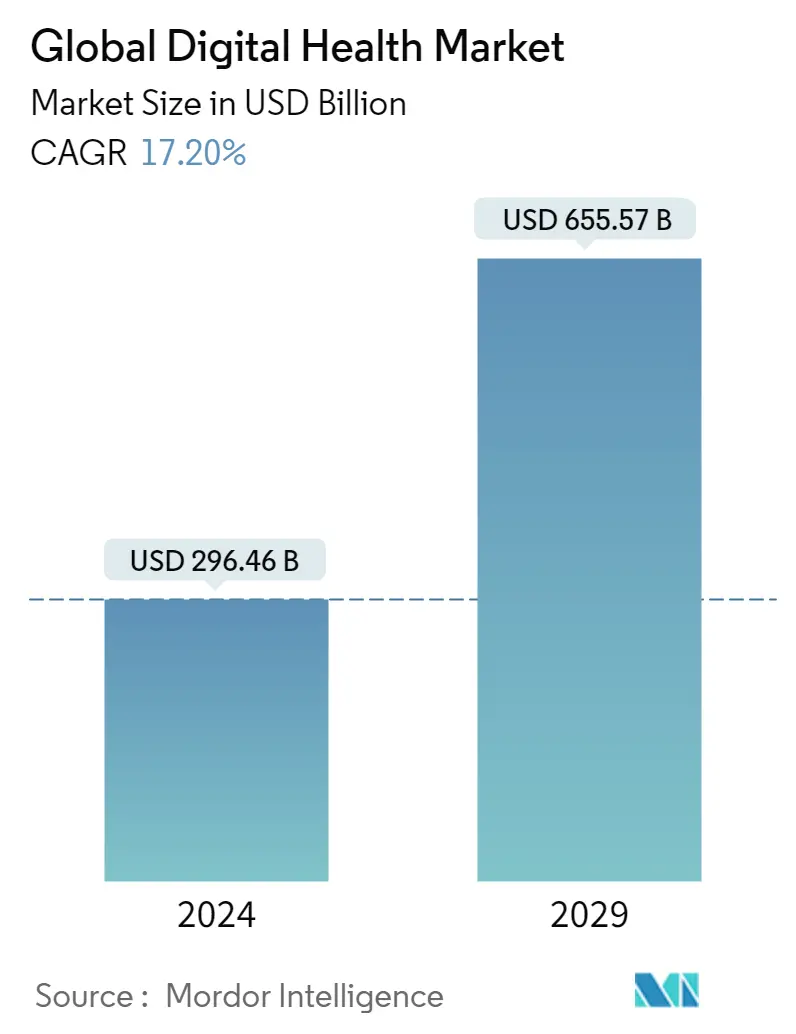Market Size of Global Digital Health Industry

| Study Period | 2019 - 2029 |
| Market Size (2024) | USD 296.46 Billion |
| Market Size (2029) | USD 655.57 Billion |
| CAGR (2024 - 2029) | 17.20 % |
| Fastest Growing Market | Asia-Pacific |
| Largest Market | North America |
| Market Concentration | Medium |
Major Players
*Disclaimer: Major Players sorted in no particular order |
Digital Health Market Analysis
The Global Digital Health Market size is estimated at USD 296.46 billion in 2024, and is expected to reach USD 655.57 billion by 2029, growing at a CAGR of 17.20% during the forecast period (2024-2029).
With the strike of COVID-19 and lockdowns all over the globe, the digital delivery of healthcare became more important than ever. For instance, according to the article "The European digital health revolution in the wake of COVID-19," published in April 2021, the European Commission proposed the EU4Health program as part of a COVID-19 recovery response program. The initiative aimed to raise EUR 5.1 billion for the digital transformation of the European health sector and ensure preparedness for future cross-border health threats. Thus, the increased investments by European governments toward the digital transformation of healthcare amid COVID-19 played a significant role in the growth of the studied market. Thus, COVID-19 had a profound impact on the growth of the market amid the pandemic phase.
The factors such as increasing adoption of digital healthcare, the rise in artificial intelligence, IoT, and big data, growing adoption of mobile health applications coupled with initiatives taken by the government are also propelling the growth of the market.
The grants provided by the government for the development of digital platforms and systems are also driving the growth of the market. For instance, in May 2021, the United Kingdom health tech company, my mhealth, and collaborators were awarded EUR 2.5 million in Eurostars Grants for the development of their project, named CUOREMA. The CUOREMA project will focus on developing a new, patient-centered cardiac rehabilitation support system.
Similarly, increasing adoption of technology and product launches are key factors for the growth of the market. For instance, in June 2021, MicroPort CRM launched AlizeaTM and BoreaTM pacemakers, which are equipped with Bluetooth technology for streamlined remote monitoring when paired with the SmartView Connect home monitor in Europe. These pacemakers help the cardiologists monitor the devices remotely and decrease the patient's need to travel to the hospital for a simple routine examination, thus reducing the burden on the healthcare system.
Moreover, in December 2020, Entremo deployed its product, a wristband, to remotely monitor the vital signs of patients in hospitals and nursing homes in Hungary. Additionally, in March 2021, the Spanish mobile network Yoigo launched a telemedicine service named "Doctor Go". The Doctor Go telemedicine service offers video consultations with family doctors and specialists, as well as telepharmacy services for electronic prescriptions and the delivery of medicines.
Hence, due to the abovementioned factors, the studied market is expected to grow significantly during the forecast period. However, security concerns regarding patient data may hinder market growth in the future.
Digital Health Industry Segmentation
As per the scope of this report, digital health, which includes digital care programs, is the convergence of digital technologies with health, healthcare, living, and society to enhance the efficiency of healthcare delivery and make medicine more personalized and precise. The Digital Health Market is segmented by Component (Hardware, Software, and Services), Technology (Telehealth, mHealth, Health Analytics, and Digital Health Systems), and Geography (North America, Europe, Asia-Pacific, Middle East and Africa, and South America). The market report also covers the estimated market sizes and trends for 17 different countries across major regions globally. The report offers the value (in USD million) for the above segments.
| By Component | |
| Hardware | |
| Software | |
| Services |
| By Technology | |
| Telehealth | |
| mHealth | |
| Health Analytics | |
| Digital Health Systems |
| Geography | ||||||||
| ||||||||
| ||||||||
| ||||||||
| ||||||||
|
Global Digital Health Market Size Summary
The digital health market is experiencing significant growth, driven by the increasing adoption of digital healthcare solutions and advancements in technologies such as artificial intelligence, IoT, and big data. The COVID-19 pandemic has accelerated the shift towards digital health, with governments and organizations investing heavily in digital transformation to enhance healthcare delivery and preparedness for future health threats. Initiatives like the European Commission's EU4Health program and various government grants have played a crucial role in this expansion. The market is further propelled by the rising use of mobile health applications, product launches, and the development of innovative healthcare solutions that reduce the need for in-person visits, thereby alleviating the burden on healthcare systems.
In North America, the digital health market is witnessing robust growth due to the high adoption of advanced healthcare technologies and supportive government policies. The demand for mobile technologies and telemedicine applications has surged, facilitating personal health management and reducing hospital visits. Partnerships, collaborations, and strategic initiatives by key players are enhancing market competitiveness and driving innovation. Despite the promising growth trajectory, concerns regarding patient data security remain a potential challenge. Overall, the digital health market is poised for substantial expansion, supported by technological advancements, government initiatives, and increasing consumer awareness and adoption.
Global Digital Health Market Size - Table of Contents
-
1. MARKET DYNAMICS
-
1.1 Market Overview
-
1.2 Market Drivers
-
1.2.1 Increasing Adoption of Digital Healthcare
-
1.2.2 Rise in Artificial Intelligence, IoT, and Big Data
-
1.2.3 Growing Adoption of Mobile Health Applications
-
-
1.3 Market Restraints
-
1.3.1 Cybersecurity and Privacy Concerns
-
-
1.4 Porter's Five Forces Analysis
-
1.4.1 Threat of New Entrants
-
1.4.2 Bargaining Power of Buyers/Consumers
-
1.4.3 Bargaining Power of Suppliers
-
1.4.4 Threat of Substitute Products
-
1.4.5 Intensity of Competitive Rivalry
-
-
-
2. MARKET SEGMENTATION (Market Size by Value - USD million)
-
2.1 By Component
-
2.1.1 Hardware
-
2.1.2 Software
-
2.1.3 Services
-
-
2.2 By Technology
-
2.2.1 Telehealth
-
2.2.2 mHealth
-
2.2.3 Health Analytics
-
2.2.4 Digital Health Systems
-
-
2.3 Geography
-
2.3.1 North America
-
2.3.1.1 United States
-
2.3.1.2 Canada
-
2.3.1.3 Mexico
-
-
2.3.2 Europe
-
2.3.2.1 Germany
-
2.3.2.2 United Kingdom
-
2.3.2.3 France
-
2.3.2.4 Italy
-
2.3.2.5 Spain
-
2.3.2.6 Rest of Europe
-
-
2.3.3 Asia-Pacific
-
2.3.3.1 China
-
2.3.3.2 Japan
-
2.3.3.3 India
-
2.3.3.4 Australia
-
2.3.3.5 South Korea
-
2.3.3.6 Rest of Asia-Pacific
-
-
2.3.4 Middle East and Africa
-
2.3.4.1 GCC
-
2.3.4.2 South Africa
-
2.3.4.3 Rest of Middle East and Africa
-
-
2.3.5 South America
-
2.3.5.1 Brazil
-
2.3.5.2 Argentina
-
2.3.5.3 Rest of South America
-
-
-
Global Digital Health Market Size FAQs
How big is the Global Digital Health Market?
The Global Digital Health Market size is expected to reach USD 296.46 billion in 2024 and grow at a CAGR of 17.20% to reach USD 655.57 billion by 2029.
What is the current Global Digital Health Market size?
In 2024, the Global Digital Health Market size is expected to reach USD 296.46 billion.

